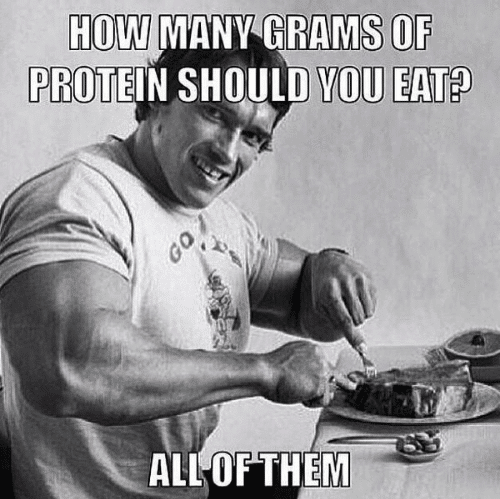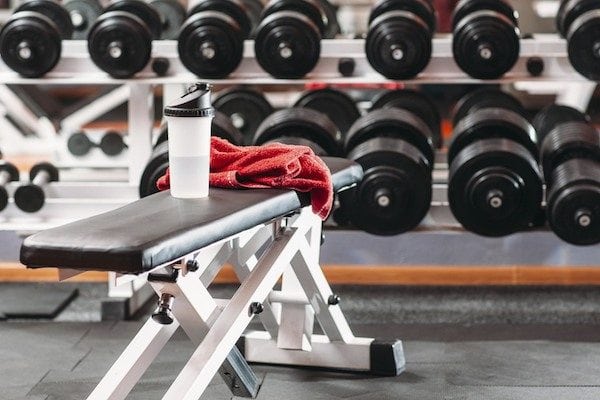No products in the cart.
How to Gain Mass as a Hardgainer : 15 Essential Tips

Building muscle is something that is easily promised, but can be surprisingly difficult to accomplish. Particularly if you are what’s known as a hard gainer.
This term relates to someone who struggles to build muscle mass, usually, the person is a guy, and they are often ectomorphic (tall and skinny).
If you are a different body shape such as endomorph (shorter and naturally bigger) you will have different problems, but muscle building probably won’t be it.
Your biggest issue is usually keeping body fat down, which involves full-body workouts, compound lifts (deadlifts, squats, bench presses), and a calorie deficit. Simple, but not easy.
Fundamentally, there are 7 reasons why hardgainers can’t gain weight, these are as follows:
- Not enough food and not tracking your foods with a food diary
- Wrong food choices and lack of calorie-dense foods
- Too much activity throughout the day e.g. a physically demanding job
- Training wrong, using isolated exercises and not compound exercises
- Trying to avoid gains in % body fat
- Lack of consistency, faith and motivation
- You blame your genetics
Which one or more of the above reasons do you use as an excuse for not gaining weight or muscle?
The purpose of this article is to identify common issues and mistakes that affect hardgainers and help rectify the situation.
This is only going to work if you are honest with yourself and your current situation. Getting defensive is not going to lead to change, and if you are a hard gainer reading this article, then you need things to change! [toc]
Tip #1: Stop Blaming Your Genetics
If you are a hardgainer then you may think that it is all down to your genetics.
While this may have an impact, you cannot let it get you down as this will only leave you wanting to quit.
Instead, look at ways that you can overcome these genetics. There are plenty of ways that your lifestyle, training habits and nutrition can all help add muscle mass.
Tip #2: Not Eating Enough

Most hard gainers will tell you that they eat plenty, they’ll boast (or complain) that they can eat anything that they want without gaining weight.
Well, sadly this is rubbish. Science is pretty inflexible when it comes to energy balance.
If you are eating more than you are burning you WILL gain weight. Eating fewer calories than you are burning then you will lose weight. If your calories in and your calories out are equal you will stay the same.
So if you are not able to gain weight then you are almost certainly not eating enough calories.
If you are eating loads and still not gaining weight then your energy expenditure is probably very high.
Do you walk a lot? Fidget? Exercise regularly? All of these things will burn calories, which means that if you want to gain weight then you’ll have to boost your calorie intake further.
What I would suggest is to use a calculator such as this one from Precision Nutrition [1] to find out what your daily calorie intake needs to be so that you can gain weight. Then start tracking your calorie intake using a website or app such as MyFitnessPal.
Not only will this help you to find out what your average calorie intake is, but it will also help you find foods that bring you closer to your goals.
A lot of the advice thrown at skinny people is basically “eat all the time”, you’ll see people recommending eating 7-10 meals per day.
Some guys wake up during the middle of the night just to get an extra meal in.
This is stupid because meal frequency does not matter. It’s all about calories in versus calories out.
If you need to eat 3000 calories to create a calorie surplus then it doesn’t matter if that all comes in 3 meals, or spread out into 5.
Your best bet is to keep things simple, if you are used to eating 3 meals per day and having a couple of snacks, then stick to that formula.
Look for calorie-dense foods (peanut butter has lots of calories for a small serving) and look to add protein. But keep the structure the same.
Don’t stuff your stomach with a huge quantity of low-density foods such as fruits & vegetables, for the purpose of trying to load your body with calories. These food types will make you feel full and this is rather uncomfortable in and out of the gym.
That is not to say that veggies are not healthy, but for the hardgainer, the focus should be on foods such as steak, whole eggs, oatmeal and dried nuts. As these food types will be a lot higher in calories and most hardgainers need to be consuming about 25 calories per kg of body weight per day, to pack on the muscle.
This should equate to above 5000 kcals per day and if you still are not gaining weight add more calories into your nutrition plan.
If you are currently consuming 2000 calories per day and you found out that you need to eat 2,500 calories per day to build muscle, then cramming in 4,000 calories immediately is not going to work. You’ll feel sluggish, you’ll gain too much body fat, and your sleep will be affected.
Add in 50-100 calories per day, each week (2100 week one, 2200 week two etc) and take your time.
Tip #3: Drink Some Calories
In addition to the pre and post work out shakes, aim to drink at least another shake per day.
Liquids will fill you up far less than solids and are packed with calories; this should help you to achieve your calorie intake for the day.
Add the following high calories ingredients to your shakes or buy a weight gaining shake:
- Peanut butter
- Flaxseeds
- Coconut oil
- Oats
- Greek yoghurt
In addition, drink 4 litres of whole fat milk per day, every single day no matter what.
Tip #4: Hit Your Protein Targets
This tip follows on from the last, but it’s so important that it requires its own section.
To build bigger muscles you need the required protein. Without that protein, you won’t grow.
To find out your correct protein intake target for the day, you should use the following equation:
Lean Body Mass (kg) multiplied by 2.3 = protein target (grams)
So if you are 70kg and only 15% body fat then your lean body mass (the weight of everything except body fat) would be 70 – 10.5 (15% of 70). Which equals 59.5kg.
You would then multiply 59.5 by 2.3 which equals 136.85g. Your new target.
This equation comes from a landmark study by Helms, Aragon, & Fitschen (2013) [2]. They actually recommend anywhere between 2.3 and 3.1g per kg of lean body mass, but we used the lower end here.
Tip #3: Eat The Right Carbs
Load up on the carbs post-exercise, as this strategy will give your body the right nutrients to boost glycogen stores and will be the platform for recovery.
This is prime time for muscle building and for repair; load up on carbs such as dextrose and maltodextrin.
If you are not already carbo-loading post-exercise, then this should be your first adjustment to your nutrition plan, as this improves recovery rates and strength gains. If you are stronger, you can pump more weight and increase muscle mass a lot quicker.
Two hours before you train I would recommend eating whole wheat pasta, as 250grams of pasta = 1000kcals. Also go heavy on the bananas, as they are packed with calories!
Tip #4: Eat The Right Fats
Add omega 3-s and saturated fats into your nutrition plan and don’t substitute your carb intake with fats. Both macros should be included, fats are highly calories dense and help to stimulate muscle growth.
Healthy fats from fatty fish, nuts and coconut oil are a must for the hardgainer e.g. 100 g of nuts= 500 kcals.
Tip #5: Supplement
No, you don’t need to spend your entire paycheck on mass gainers, but at the very least you should be thinking about whey protein.
It’s actually one of the cheapest protein options per serving, can be used as a snack, can be mixed with Greek yoghurt and oats for a high protein/high-calorie dessert, and is easy to transport around with you.
The extra protein in your day will help with recovery, and the protein to calorie ratio is perfect for anyone trying to bulk.
Tip #6: Not Training Enough
You want to build as much muscle as possible but you don’t want to spend more than three hours per week in the gym? Good luck with that!
We’re not saying that you need to be there 24 hours a day, 7 days per week (in fact overtraining is one issue that we’re going to cover later in this article), but three sessions per week is not going to lead to noticeable changes.
Training 4-5 times per week is probably the perfect ratio of rest to work. Giving you enough time to hit all muscle groups while also allowing you enough time to recover.
If you are just starting out then three times per week is probably enough. However, if you’ve been training for a while and are not seeing results then maybe your workload is too light?
You need to find time to train four times per week, for 45-60 minutes per session.
Get into a routine, and create a program that will reflect the extra gym time you have available now. Training more will require better recovery, so check out our next point below.
Tip #7: Not Recovering Properly

Proper recovery is often a completely overlooked and underrated factor in muscle gains, but the truth is that without optimal recovery you will never gain muscle.
Nutrition is a big factor which we have covered slightly already.
Increasing your protein intake to 2.3g of protein per kg of lean body mass (how much you weigh minus body fat) will help you get sufficient protein for recovery and muscle gain.
But it’s not just nutrition, adequate sleep is also massively important. Getting 8-9 hours a night is necessary for anyone looking to gain size.
Less sleep can lower testosterone and increase cortisol, which will lead to muscle loss (worst case scenario) or a lack of growth.
Scheduled rest days are also important, which is why we didn’t recommend training 7 days per week.
Rest your muscles, sleep more, hit your protein targets, and consider recovery supplements (whey or casein protein is usually good enough).
If you are looking to build strength or increase hypertrophy then you should be resting for 3 minutes between sets.
This has been shown to be the most effective time for recovery. It will allow you to lift more, and for more reps (if required) and will help hit more muscle fibres.
Tip #8: Being Stubborn
We’re at point #8 and already some of you will have yelled angrily at the screen that “NONE OF THIS APPLIES TO ME”.
Maybe this is true, but most likely you’re just being stubborn or defensive. You’re set in your ways, can’t teach an old dog new tricks etc … Well, stop it.
You opened this article because it identified a problem that is affecting you. If you are claiming to be a hard gainer, then something that you are doing is wrong.
You need to change your mindset, your current program, recovery plan, nutrition, or overall strategy is not working, why is that?
Introspection is one of the most useful things that you can do. And that can help with business, family, and financial issues, so why not apply it to muscle gain?
Tip #9: Being A Gym Butterfly

Last week you were following a 5×5 program, but this week its German Volume Training, which you will follow until you get bored. Then if you don’t feel that your results are coming quick enough, then you will ditch in favour if circuit training. Or prhaps your friend’s bodybuilding program that he printed off the internet.
Swapping your program every few weeks is a great way to never grow muscle. You’re not giving your body enough time to adapt to the program, and therefore it can’t progress.
Constantly looking for that magic program that will give you amazing results, is preventing you from actually getting the results that you crave.
Pick a program that is aimed at people similar to yourself. Follow that program for 4 months, evaluate your progress.
You’ll be pleasantly surprised at the results you have got by sticking to a program.
If you want to build strength or build size (or both) you’ll need to be consistent with your training, and work hard.
Creating a calorie surplus will backfire on you if you aren’t using that extra energy to exercise harder and for longer.
Three times per week should be a minimum, but if you can try and do more.
Resistance machines are great, and definitely have their place in most programs (particularly beginners’). But if you are really looking for results then the hormonal response is far superior with free weights [3].
A barbell squat will produce more testosterone and growth hormone (both necessary for muscle growth) than a leg press, as it is a more difficult exercise to perform.
Use what time you have available in the gym to get the absolute most out of it.
Tip #10: You Aren’t Tracking Progress
This mistake is so frustrating to witness as an outsider.
It’s the person who doesn’t bother taking before pictures or measurements at the beginning of a program, doesn’t track progress throughout the program and then complains that they aren’t seeing progress.
How do you know?
Gaining 2kg of muscle in 3 months is actually decent progress, but you won’t see the difference. You need to take progress photos and measurements so that you can see how you’re progressing.
Before starting a program weigh yourself on a set of scales. Take a topless photo of yourself (not flexing), and use a tailor’s measuring tape to take measurements of your waist, legs, arms, chest, calves etc … Each week take the same measurements and photo and record your results.
Tip #11: You Are Being Impatient

It can take 12 weeks before any real changes are noticeable to the naked eye, it can take years for a complete body transformation.
So why are you getting frustrated and quitting after 3 weeks? Because you are being impatient.
It’s not your fault, years of immoral advertising from elements of the fitness industry have made people expect instant changes to their body, but this is unrealistic.
Be patient, be proud of small changes, and look at the bigger picture.
Tip #12: Bad Exercise Selection
You’re looking to build serious muscle mass, but you don’t like squatting? Or deadlifting?
You’ll spend 30 minutes on abs because you like your six-pack, and then complain that you can’t build a big chest!
If you want to build serious muscle, then you’ll have to leave that comfort zone and work hard. It may not be as fun, but neither is being a hard gainer!
Write a list of the exercises you hate most. It’s likely that deep down a lot of the exercises you are avoiding are excellent for building muscle.
Put them into your program, and start each session with them.
I would also recommend binning the isolation exercises and perform compound exercises instead.
Compound exercises include the following:
- Bench press ( including incline & decline)
- Bent over rows
- Shoulder press
- Pull-ups
- Chin-ups
- Lunges
- Squats
- Deadlifts
The major benefit of compound exercises is that you are using and recruiting more muscle fibres during the whole movement. Therefore, you will be able to lift heavier weight and this translates to more rapid strength gains.
This increase in strength gains is especially evident in beginners because building a solid foundation of lean muscle is achieved via heavy lifting. Rationale dictates that you will always lift more total weight when performing compound exercises.
Another key benefit of using compound movements is that you are reducing the overall time of your workouts. In simple terms, you will be working major muscle groups instead of singular muscles and so you will be saving time by performing compound movements.
Realistically, you can accomplish a whole body work out in about 5 compound exercises and just think ‘How many isolation exercises you would have to perform to get the same full-body results?’
Therefore, for the hardgainer less volume of weight is usually better. Keep your rep range low and increase your rest intervals in between sets to about 120 seconds.
If you force yourself to do another set before you have recovered, you will not see the maximal muscle gains.
Tip #13: Poor Technique

Bench pressing with a tiny range of motion, bicep curling with huge swings of the arms, bent over rows that aren’t bent over.
There is so much bad form going on in the gym that it is no surprise that many employ dedicated physios! Bad form will lead to injury, but it can also prevent proper muscle growth.
Did you know that you can gain more muscle fibres while lowering a weight than curling it?
Imagine how much you’re missing out on if you aren’t using proper form or tempo.
Lose the ego and work on proper form rather than trying to lift the heaviest weight possible.
Tip #14: You Aren’t Consistent
Consistency makes all the difference. There is not a strategy that will succeed without you consistently following it through to its conclusion.
When following a calorie target, then you’ll only see a result if you consistently hit that target over time.
If you are following a program 4-5 times per week, then you have to stick with that program and consistently turn up to the gym to do it.
If you are looking to improve your recovery then you need to consistently sleep enough hours, eat enough, and foam roll enough to recover.
Doing things once and then forgetting about them will not lead to change.
Try not to change too many things at once. Make one small change and concentrate on successfully managing to act on that change until it becomes a habit.
Then add another change, and another, each time giving yourself enough time to adapt and accept the change in your routine.
Tip #15: Focus on your goals
If you want to gain muscle as a hardgainer then you need to make sure you focus on this goal.
Do not be discouraged by a lack of success. Perhaps you just need to make a couple of changes to what you are eating or lifting to start seeing positive results.
Simply giving up is not the answer and will not result in the gains that you desire.
Final Words of Advice
Finally, believe that you are not a hardgainer and that you were eating and training all wrong; then you will start to see some muscle mass gains.
Remember to log and track your progress by taking pictures throughout the whole process, and monitor all of your foods along with the training that you have completed. Good luck.
For further tips on how to bulk effectively, I would recommend the following guide.

How much protein should I consume as a hard gainer?
According to research you should aim to consume between 2.3g and 3.1g of protein per kg of lean body mass.
However, this does not necessarily mean that a 100kg person should be consuming 230-310 grams of protein though.
Lean body mass is a measure of your body’s weight MINUS your body fat. So if you weigh 100kg but have a body fat percentage of 20 then your lean body mass would be 80kg rather than 100kg. That means that you should be aiming to consume between 184g and 248g (depending on whether you used 2.3g or 3.1g per kg) daily.
As you will notice, the amount of protein you decide to take can vary by quite a bit (64g in this case) and you’ll still get good results.
I would also recommend that you look at your overall calorie intake, and your Resting Metabolic Rate. Make sure you are consuming more calories than you need to maintain your current weight. You may surprise yourself when you realise how little you actually consume.
I am a hardgainer how to eat more? Any ideas?
We have the perfect article for you. Check this out. 🙂
WHich whey is your favourite?
Brian, I would recommend the whey protein sold by Battle Ready Fuel. 🙂
No such thing as a hardgainer, you’re just not eating enough.